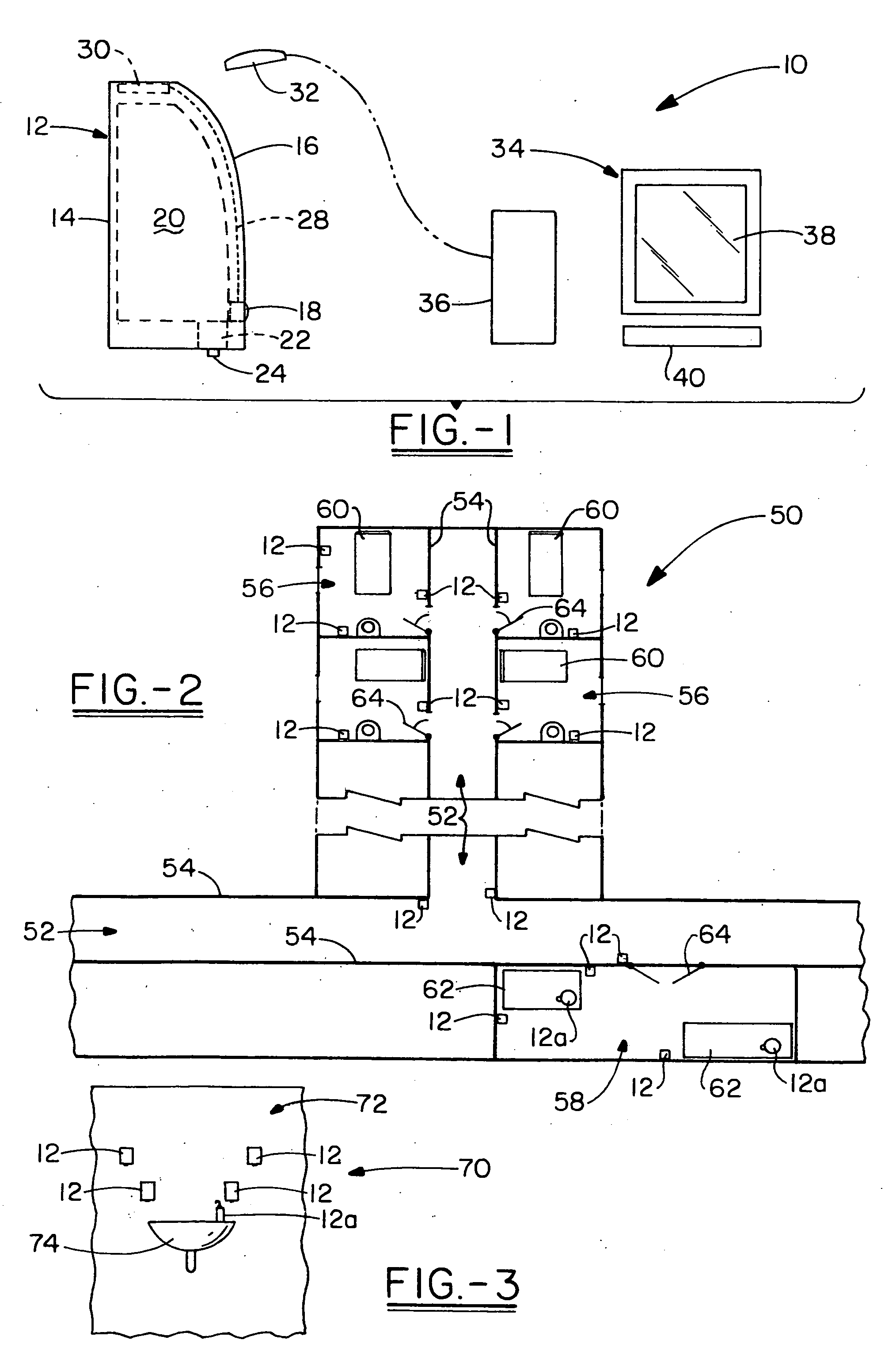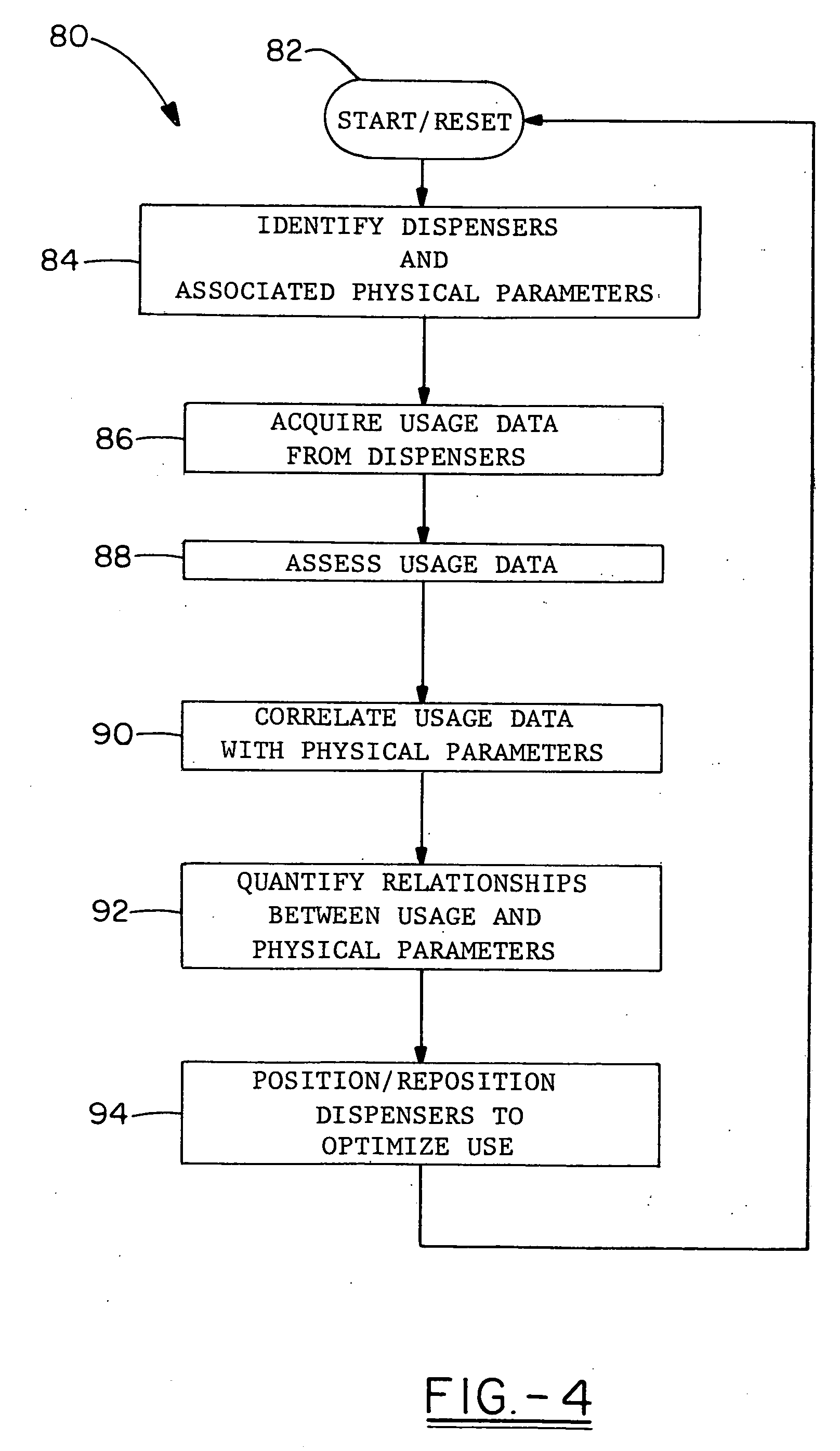Method and apparatus for analysis and improvement of hand hygiene practices
a hand hygiene and hand hygiene technology, applied in the field of hand hygiene practices, can solve the problems of general temporary and inconvenient modification of behavior, and achieve the effect of improving hand hygiene practices
- Summary
- Abstract
- Description
- Claims
- Application Information
AI Technical Summary
Benefits of technology
Problems solved by technology
Method used
Image
Examples
example 1
[0039]In a first situation, all 126 wall-mounted soap and hand sanitizer dispensers in four wards in two acute-care hospitals were fitted with hand hygiene event recorders of the general type discussed above. The recorders were not visible to dispenser users and electronically determined, recorded and displayed a running total of the total number of hand hygiene events for each dispenser. The totalized number of each dispenser was manually read and transcribed to a datasheet at predetermined time intervals, typically 12 hours, which corresponded to the work shift times of the majority of healthcare workers in the wards. The number of hand hygiene events for a given time interval was calculated by subtracting the prior total from the current total of events recorded. This hand hygiene data was recorded over a period of 13 weeks.
[0040]At the same time, hand hygiene of the healthcare workers in the study wards was measured by a trained observer method. Four observers were uniformly tra...
example 2
[0043]A study was conducted to determine the impact upon hand hygiene rates of placing wall-mounted hand sanitizer dispensers inside of patient rooms in addition to placement outside of the rooms. Two wards (one, an intensive-care unit and the other, a general medical-care unit) in an acute-care hospital were outfitted with the electronic hand hygiene recording devices described above. Recording was put in place for dispensers of hand sanitizer both inside (bedside) and immediately outside (corridor) of 23 patient rooms. Hand hygiene events were recorded for 60 days, during which 1,846 unique events were registered. The hand hygiene event data were statistically analyzed to determine patterns of use between inside and outside room placement of dispensers. To do this, the data was superimposed upon a physical map of the two wards of interest to correlate usage data with location data. It was found that 48% of the hand hygiene events occurred at the inside room dispensers, and a signi...
example 3
[0044]In a 23-bed acute-care hospital ward, six patient rooms that were outfitted for contact isolation (contagious disease) precautions were equipped with a hand hygiene event monitoring system as presented above. Both soap and hand sanitizer dispensers were then monitored for seven months. The hand hygiene measurement data from the electronic monitoring devices was transferred to an overlay of the ward, as presented above. An analysis of the data showed that hand hygiene with soap and water was highly preferred over hand sanitizer use in these rooms due to the location of the hand soap and the overall flow of work needed to practice isolation precautions. It was further determined that physical placement of the hand sanitizer dispensers had relatively minor effect on usage rates, and, therefore, no changes in number or physical location of sanitizer dispensers were needed. Rather, resources were used to re-emphasize hand-washing practices in the contact precaution rooms. Here, whe...
PUM
 Login to View More
Login to View More Abstract
Description
Claims
Application Information
 Login to View More
Login to View More - R&D
- Intellectual Property
- Life Sciences
- Materials
- Tech Scout
- Unparalleled Data Quality
- Higher Quality Content
- 60% Fewer Hallucinations
Browse by: Latest US Patents, China's latest patents, Technical Efficacy Thesaurus, Application Domain, Technology Topic, Popular Technical Reports.
© 2025 PatSnap. All rights reserved.Legal|Privacy policy|Modern Slavery Act Transparency Statement|Sitemap|About US| Contact US: help@patsnap.com



